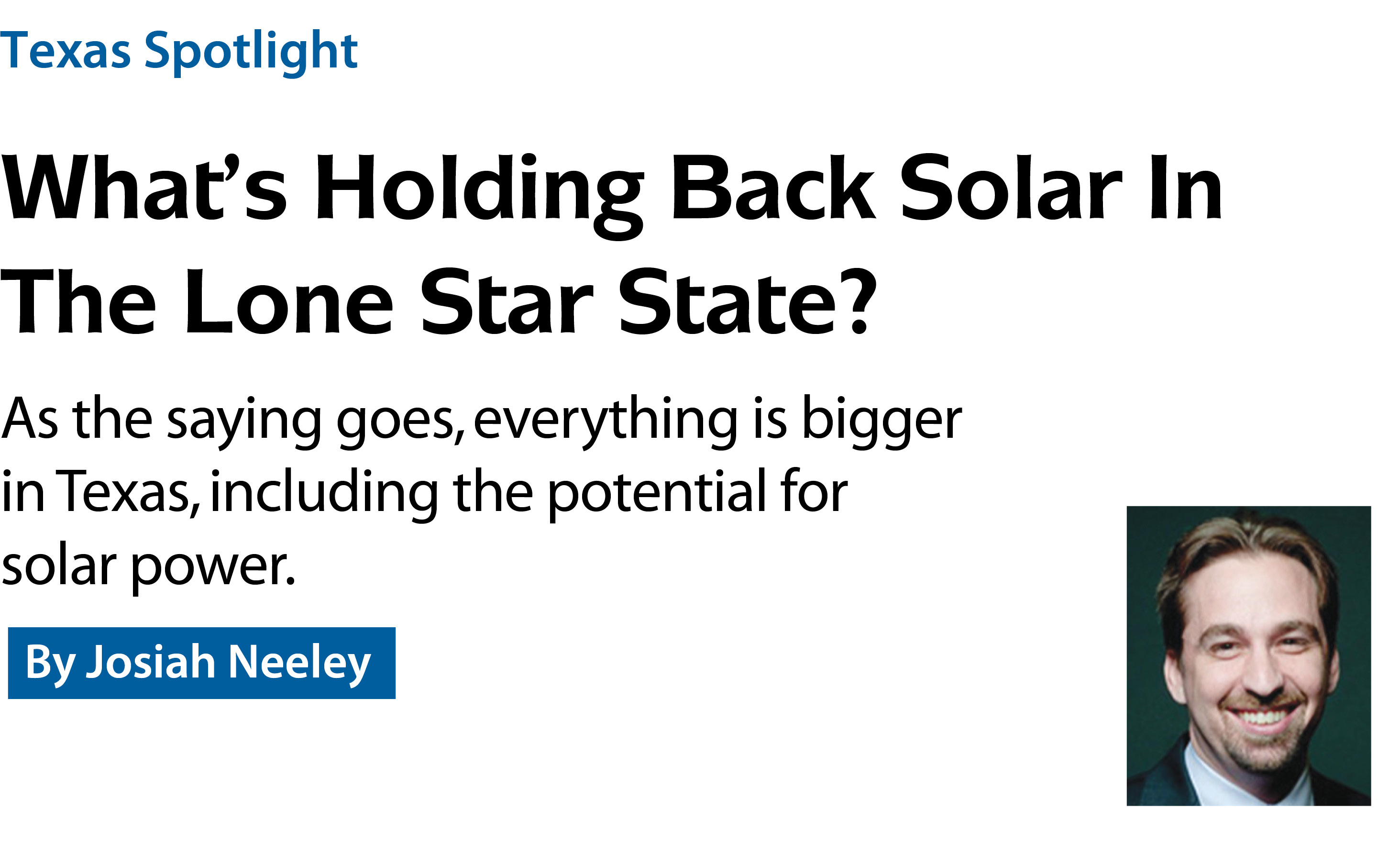

301 Moved Permanently
Texas is known for being a sunny place - literally. El Paso County is in the top 1% of U.S. counties for the amount of sunshine received each year. Although things are a bit cloudier in the eastern part of the state, the National Renewable Energy Laboratory ranks Texas first among the states in solar power potential.
All of that sunshine, however, hasn’t always translated into more use of solar power. The Solar Energy Industries Association (SEIA) recently ranked Texas 10th in the U.S. regarding installed solar capacity. That’s not bad, but it is still far below the state’s potential (in Texas, we like to be No. 1). And although SEIA expects utility-scale solar to accelerate in Texas this year, there remain several barriers to the growth of the state’s overall solar market.
The reasons Texas still lags in installed solar power are complex. A big factor is cost, but what matters more than the cost of solar itself is its relative cost compared with other sources of electricity. Analysis by Lynne Kiesling of Northwestern University found that states with higher electricity prices had greater amounts of installed solar capacity. When electricity is cheap, it may not be worth the trouble for a consumer to install panels on his or her home. However, as prices rise, a solar system starts to look more attractive.
Texas is in the middle of the pack when it comes to electricity prices. The state relies more heavily on natural gas as a source of electricity, and natural-gas prices have fallen substantially over the last decade. To that extent, market forces are behind why Texans don’t use more solar.
But those forces may be changing. A recent study by the Brattle Group conducted on behalf of the Texas Clean Energy Coalition found that, if solar prices continue to decline as projected, the state would have 13 GW of utility-scale solar capacity by 2021. That’s not counting any additional power generated from rooftop solar. Even at current prices, many are finding solar increasingly attractive. In 2014, Austin Energy, Austin’s electric utility, signed a 25-year contract for 150 MW of solar-powered electricity for slightly less than $0.05/kWh. More recent bids have been even lower.
Markets are a big part of the story, but they aren’t the only relevant factor. Policies such as net energy metering (NEM) also have a significant impact. Perhaps unsurprisingly, people are far more likely to install rooftop solar if they can sell back their excess generation at an attractive rate. In effect, NEM lowers the relative cost of solar when compared with other sources of electricity. While a few Texas localities have NEM programs, most of the state operates under a competitive electric system that doesn’t necessarily mesh well with a NEM mandate.
Financing can also be a serious impediment to Texas solar. Even if the lifetime cost of generating electricity from rooftop solar is significantly less than the cost of using energy from the grid, many consumers are unwilling or unable to bear the larger upfront costs of installation. Even large commercial and industrial customers may have trouble financing installation projects. A business that installs solar panels on its buildings may end up selling the property before it has had time to recoup the investment.

A number of new financing mechanisms have been developed to overcome the disincentive presented by solar’s upfront costs. The first of these is property assessed clean energy (PACE) financing. With PACE, instead of a property owner borrowing money to finance a solar installation, the money is in essence borrowed by the property itself. The loan is repaid via a voluntary increase in the property-tax assessment. Because the obligation attaches to the property, rather than to an individual owner, this scheme eliminates the problems that might otherwise arise if the property is sold before the loan is fully repaid.
PACE programs are generally focused on commercial and industrial properties, rather than on residential housing. The reason for this is largely regulatory. In the wake of the financial crisis, Fannie Mae and Freddie Mac adopted policies not to buy mortgages from residential properties encumbered by PACE liens. Because Fannie and Freddie hold a majority position in the secondary mortgage market, this policy has precluded widespread use of PACE in the residential market.
The growth of commercial PACE in Texas has been slow but steady. The Texas legislature granted localities authority to implement PACE financing for commercial properties in 2013. Eligible projects include not just solar installations, but also a wide variety of energy-efficiency and water-efficiency improvement projects. The Texas program also stresses the importance of having funds come from the private sector rather than from the government. The government is involved only in providing the mechanism for repayment.
The first active program was launched in Travis County in March 2015. Similar programs have since been adopted in Houston and Dallas, and Williamson County approved its program in April 2016. As of this writing, PACE programs are being considered in numerous other localities throughout the state.
While PACE is focused on commercial properties, other financing mechanisms have been developed that target residential properties. One increasingly popular option involves what are known as “third-party power purchase agreements.” Instead of buying a solar system outright, homeowners lease them from a solar company, which owns the panels and pays all upfront costs. The company sells the electricity generated either to the homeowner at a set rate or back to the grid.
Utilities themselves are also getting in on the act. CPS Energy, a San Antonio utility, has launched a new program through which it will install solar panels on residential homes, retaining ownership of the panels while giving a fixed monthly credit to participants.
Another option is on-bill repayment. Similar to PACE, with on-bill repayment, instead of repaying a clean energy loan via a property-tax assessment, individuals make payments through an assessment included on their monthly utility bill. To qualify, an individual’s total expected utility bill must be lower than it would have been without the energy-saving improvements. Repayment rates for utility bills historically have been quite high, indicating that on-bill repayment can be a low-risk option for lenders. On-bill repayment is available in some states, such as Hawaii and New York, but it has not yet been approved in Texas. According to the Environmental Defense Fund, adoption of on-bill repayment in Texas could result in $5.76 billion in clean energy investment over a 12-year period.
In addition to financing issues, the growth of solar can be impeded by land-use restrictions and other local regulations. Permitting for solar installations can be challenging, particularly for non-experts. The rules vary greatly by locality. Some jurisdictions are fine, while others impose high fees or confusing processes. As the number of solar installations grows, keeping track of the myriad local rules and restrictions becomes more costly, especially for companies that operate statewide.
Regulation by homeowners associations or zoning boards may place limits on property owners’ ability to install solar panels on their homes, particularly in new developments. Under Texas law, developers have the right to prohibit solar installations on homes in certain housing developments as long as they continue to build new units. The prohibition, which applies even to already-sold homes, can be a significant impediment to the growth of rooftop solar, particularly given that developments can take years to be fully built out. Starting in 2015, this authority was limited to developments with fewer than 51 planned units.
Looking ahead, Texas’ solar capacity is likely to grow rapidly in the next few years, primarily as a result of market forces driving down costs. Policy changes are harder to predict, but recent legislation and regulation, from PACE to zoning, have tended to remove barriers to solar rather than create new ones. Unless that changes, Texas may soon become a leader in new solar generation.
Texas Spotlight
What’s Holding Back Solar In The Lone Star State?
By Josiah Neeley
As the saying goes, everything is bigger in Texas, including the potential for solar power.
si body si body i si body bi si body b
si depbio
- si bullets
si sh
si subhead
pullquote
si first graph
si sh no rule
si last graph